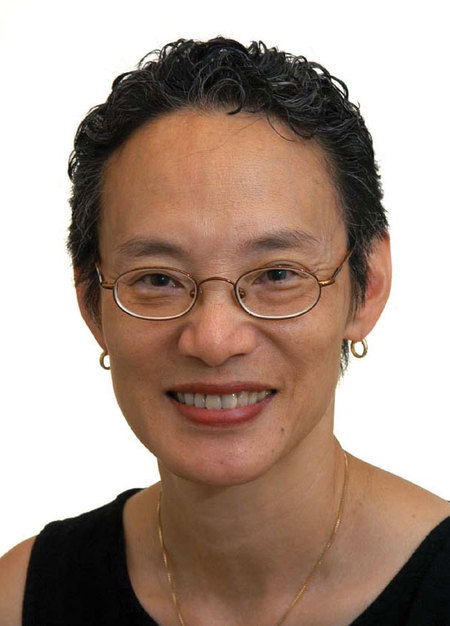An egg in my neck: Differential diagnosis of a calcified thyroid nodule
An 83-year-old Haitian woman was referred to the endocrine clinic for a thyroid nodule. The nodule was detected incidentally on a chest radiograph (Figure 1) obtained during an admission for ischemic cardiac chest pain.
 Karen Choong |
 Stephanie L. Lee |
The patient is a recent immigrant to Boston. She has noted the �bump in her neck� for more than 40 years. Although she was briefly on thyroid medication in Haiti, she has not been on any medication for years. She denies changes in the nodule size or problems with breathing or swallowing. Her voice is unchanged. She denied any symptoms of hyperthyroidism or hypothyroidism. She denied a family history of thyroid disease or a history of head and neck radiation.
Her medical history is significant for untreated hypertension and ischemic heart disease. A recent cardiac catheterization revealed multivessel coronary artery disease. Transthoracic echocardiography showed an ejection fraction of 22% and a severely depressed left ventricular systolic function, as well as grade 2 aortic and mitral regurgitation.
Physical exam revealed an elderly, thin woman in her 80s in no acute distress. Thyroid exam was significant for a 5-cm firm nodule at the inferior aspect of the left thyroid lobe extending below her clavicle. The nodule was nontender and mobile. The rest of the thyroid gland was unremarkable. Her Pemberton�s sign was negative. Pertinent labs included a recent normal thyroid-stimulating hormone of 1.6 mIU/L.
Thyroid ultrasonography (Figure 2) documented a large calcified thyroid nodule measuring approximately 3.1 cm � 3.3 cm � 5.8 cm replacing left lobe of the thyroid gland. The heavily calcified nodule was difficult to image on ultrasound because of the severe posterior shadowing and hyperechoic reverberation artifacts from the macrocalcifications. There were no microcalcifications or hypervascularity noted by Doppler analysis.
Calcification identified
Calcification is frequently found during an ultrasound exam of the thyroid. Various patterns of calcification are seen, including �egg-shell� or rim-like peripheral calcification, coarse dense calcification and microcalcifications, but their clinical significance of all these types of calcifications remains unclear to most clinicians.
Histologically, thyroid calcifications can be divided into two categories: psammoma bodies or dystrophic calcifications, which present on ultrasound exams as microcalcifications and macrocalcifications, respectively. Psammoma bodies represent laminated spherical concretions and are usually round to ovoid in shape. These appear as microcalcifications, small punctuate hyperechoic foci without reverberation or acoustic shadowing. They are a characteristic finding in papillary thyroid cancer and are thought to originate from thrombosis of the fibrovascular core and infarction of papillae in a tumor.
|
Photos courtesy of: Stephanie L.
Lee, MD, PhD |
|
|
Psammoma bodies can be present in other nonmalignant thyroid pathology such as in multinodular goiter and follicular adenomas. Microcalcifications correlate with papillary thyroid carcinoma with an approximate 85% to 94% specificity and a 69% to 71% positive predictive value, but microcalcifications do not appear in all papillary thyroid carcinoma and have a low sensitivity of 36% to 59% in sonography studies.
However, dystrophic calcifications or macrocalcifications on ultrasound exam consist of nonlaminated, irregularly shaped concretions and commonly occur secondary to tissue necrosis, often as a reaction to the surrounding tissue damage. They can present in multiple forms, such as spicules, fragmented plates or fine granular deposits. Peripheral rim calcifications or eggshell calcification of a nodule represents varying patterns of dystrophic calcification.
Other types of calcification include coarse calcification and inspissated colloid calcification. Coarse calcification can occur alongside microcalcifications; this is the most common type of calcification seen in medullary thyroid cancer. They typically appear as dense and coarse calcification with posterior shadowing on ultrasound and can be seen on plan radiographs. Inspissated colloid calcification may mimic microcalcifications but can be distinguished by the presence of ring-down or reverberation artifact.
Most clinicians view macrocalcifications on thyroid ultrasound as indicating benign nodules, but several studies have noted the presence of malignancy with calcification patterns, including peripheral calcification, intranodular coarse calcification and spot calcification in 43%, 52% and 33% of cases. Further, when eggshell or peripheral calcification of a thyroid nodule is discontinuous, the nodules were more likely to be malignant (84.4%) than in benign nodules (52.6%; overall P<.01). The authors also noted that thickening of the peripheral calcification (64% vs. 10.5%; P<.01) and hypoechogenicity of the nodule (26.3% benign vs. 55.6% malignant; P<.01) were seen more often in malignant than in benign nodules.
Malignancy and calcification
In summary, it appears that any type of sonographically detectable calcification carries a risk for malignancy. It is well appreciated that microcalcifications carry a high risk for malignancy, especially papillary thyroid carcinoma, but other patterns of calcification should be considered a risk, especially if the pattern of the calcification shows an interruption of the rim, a thickened calcified rim or peripheral calcification in a hypoechoic nodule. In addition, clinicians need to remember that macrocalcifications are frequently seen in medullary thyroid carcinoma. The most recent revision of the 2009 American Thyroid Association Thyroid Nodule Guidelines recommends that all calcifications in a thyroid nodule require careful evaluation because of the increased risk for malignancy.
Given our patient�s age, the longstanding history of a thyroid nodule without growth or compressive symptoms, her high risk cardiac condition and patient�s refusal for any possible surgical intervention, a biopsy of the thyroid nodule was deferred. She will return to the clinic in 6 months for follow-up.
Karen Choong, MD, is a fellow in endocrinology and Stephanie L. Lee, MD, PhD, is associate chief and associate professor of medicine, both in the section of endocrinology, diabetes and nutrition at Boston Medical Center.
Disclosures: Drs. Choong and Lee report no relevant financial disclosures.
For more information:
- Cooper DS. Thyroid. 2009;19:1167-1214.
- Park M. J Clin Ultrasound. 2009;37:324-328.
- Taki S. Clin Imaging. 2004;28:368-371.


